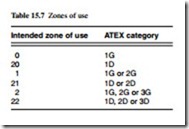Equipment marking
Prior to the 100a ATEX Directive, hazardous area equipment was marked with a ‘Certification Coding’, a certificate number and other information. A typical equipment label would contain:
● the manufacturer’s name
● the name or type of the equipment
● the ‘Distinctive Community Mark’
● a serial number
● the certification code
● the certificate number
● any ‘Special Conditions’ for safe use
● electrical ratings
● any other information required by the standards for the equipment
In a typical certification code, say EEx de IIB T3 (Tamb = 50°C), E means certified to European standards, Ex means equipment for a potentially explosive atmosphere, de means methods of protection, IIB means group and subgroup, T3 means tem- perature class and Tamb = 50°C means maximum ambient temperature. If the equipment is marked with a temperature in addition to, or in place of a Temperature Class, then this is used to denote the minimum ignition temperature of the gas or vapour.
In a typical certificate number such as SIRA01E1987X, SIRA is the name or logo of the certifying body, 01 is the year of certification, E is the revision status of the standards to which certified, 1 means the principal method of protection, 987 is the serial number of the certificate and X means that ‘Special Conditions’ for safe use exist.
The ‘Distinctive Community Mark’ equipment complies with a hazardous area
equipment directive. The 100a ATEX Directive introduces additional marking:
● the address of the manufacturer
● the year of manufacture
● the CE marking
● the number of the notified body responsible for quality assurance
● the ATEX Category
Equipment marking
Prior to the 100a ATEX Directive, hazardous area equipment was marked with a ‘Certification Coding’, a certificate number and other information. A typical equipment label would contain:
● the manufacturer’s name
● the name or type of the equipment
● the ‘Distinctive Community Mark’
● a serial number
● the certification code
● the certificate number
● any ‘Special Conditions’ for safe use
● electrical ratings
● any other information required by the standards for the equipment
In a typical certification code, say EEx de IIB T3 (Tamb = 50°C), E means certified to European standards, Ex means equipment for a potentially explosive atmosphere, de means methods of protection, IIB means group and subgroup, T3 means tem- perature class and Tamb = 50°C means maximum ambient temperature. If the equipment is marked with a temperature in addition to, or in place of a Temperature Class, then this is used to denote the minimum ignition temperature of the gas or vapour.
In a typical certificate number such as SIRA01E1987X, SIRA is the name or logo of the certifying body, 01 is the year of certification, E is the revision status of the standards to which certified, 1 means the principal method of protection, 987 is the serial number of the certificate and X means that ‘Special Conditions’ for safe use exist.
The ‘Distinctive Community Mark’ equipment complies with a hazardous area equipment directive. The 100a ATEX Directive introduces additional marking:
● the address of the manufacturer
● the year of manufacture
● the CE marking
● the number of the notified body responsible for quality assurance
● the ATEX Category
Equipment certified to the EHSRs, without supporting standards, will have only the ATEX marking.

